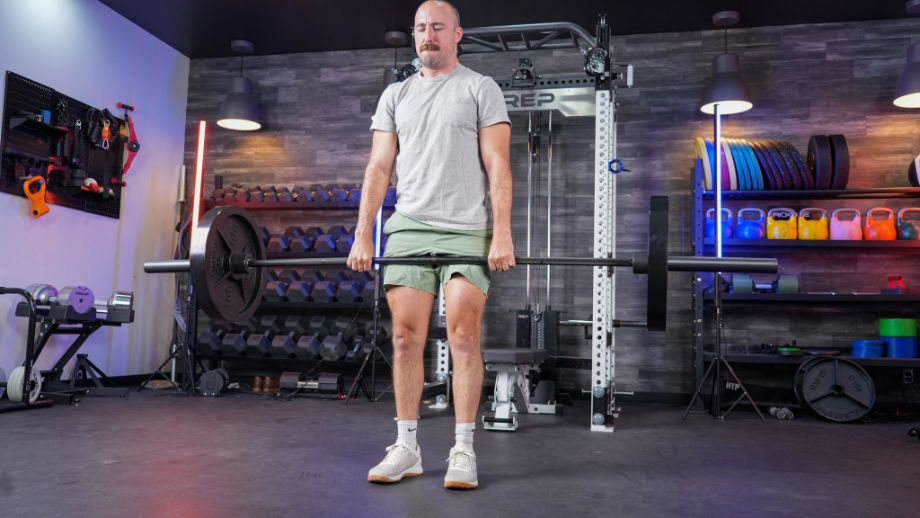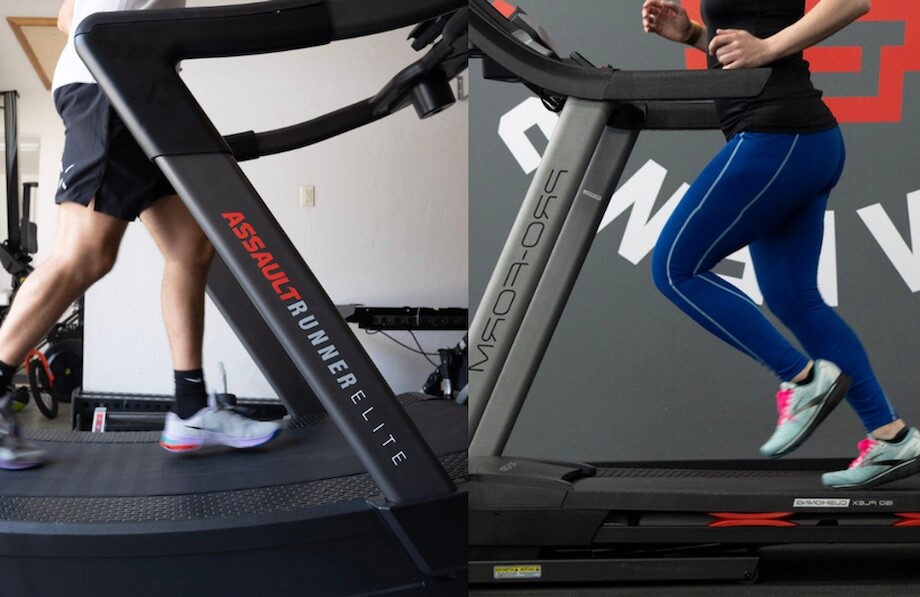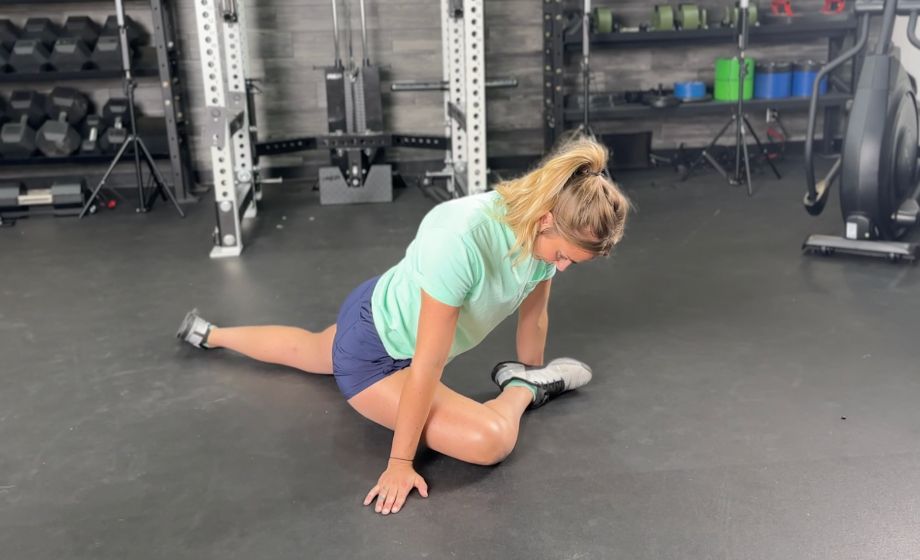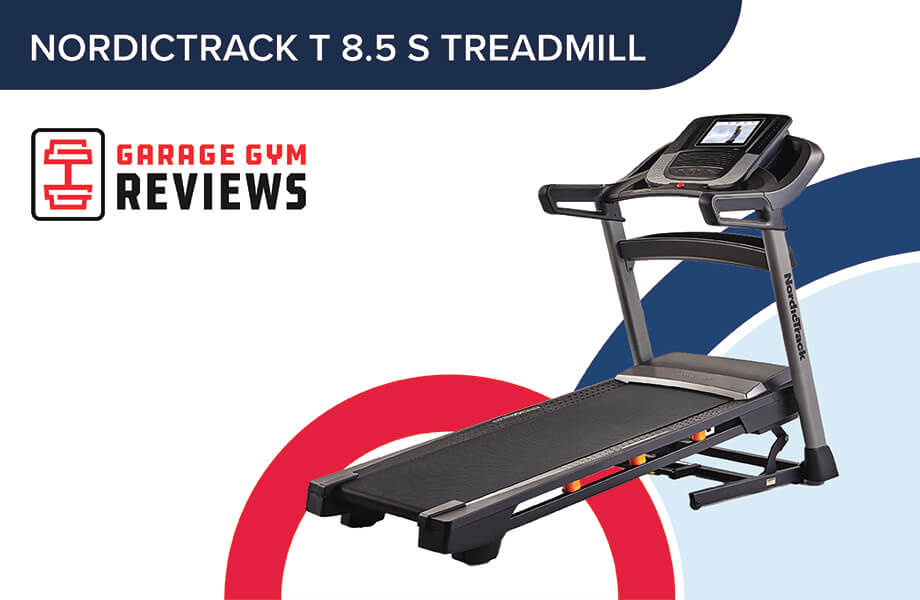For muscle growth in your lower body, two common bodybuilding exercises are squats and deadlifts. Today, we’ll be focusing on the deadlift. Popular deadlift variations include conventional deadlifts, sumo deadlifts, trap-bar deadlifts, and Romanian deadlifts (also known as RDLs). The latter of these—Romanian deadlifts—will be the cornerstone of this conversation.
A 2014 study by the Journal of Strength and Conditioning Research1 found that Romanian deadlifts are one of the best exercises to activate the hamstrings. Compared to traditional deadlifts, RDLs require you to start with a higher hip position so don’t hit the quads to the same extent. I’ll explain how to do the exercise with proper form, the benefits, common mistakes I’ve seen from my experience as a certified personal trainer (CPT), and variations for you to try.
How To Do the Romanian Deadlift
- Exercise name: Romanian deadlift
- Exercise type: Compound
- Targeted muscles: Hamstrings, glutes, spinal erectors
- Secondary muscles: Abdominals, trapezius
- Equipment needed: Barbell, dumbbells, or kettlebells
- Difficulty level: Beginner to advanced
Muscles worked: Hamstrings, lower back, glutes, core
How to do it:
- Load the barbell with the required weight, then step underneath it with your feet hip-width apart. You’ll want the bar to cover your shoelaces.
- Hinge at your hips to take hold of the bar with an overhand grip (palms facing the floor).
- Lift the barbell so you’re standing with the bar at your pelvic region.
- Activate your core before slowly pushing your hips back and lowering the barbell toward the floor. Ensure that you keep the bar close to your body.
- When you reach the middle of your shins, pause. Then, push through your heels to return to your original position.
- Continue for reps. Don’t lower the bar to the ground between reps but after each complete set.
RELATED: Best Olympic Barbell
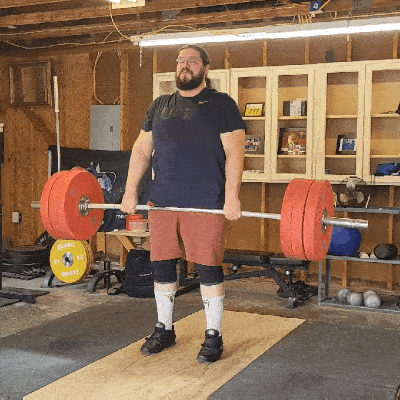
Trainer Tips for Form
If you’re new to Romanian deadlifts, or you’ve found that doing them is causing you back pain, pay attention. Here are four form tips I share with clients to get the most out of this exercise:
Brace Your Core
Before you start the movement, take a deep breath and hold it during both the eccentric and concentric phases (when you go down and back up) before exhaling. This breathwork helps you keep a tight core, protect your lower back, and reduce your risk of injury. It may result in you lifting heavier loads, too.
Hinge At Your Hips
Beginners unfamiliar with the hip hinge movement may need some practice here. Romanian deadlifts originate at your hips, not back or knees. Slowly bring your hips back until the bar reaches the desired position, then push your hips forward to return the bar to standing. Start light and practice this movement before going too heavy.
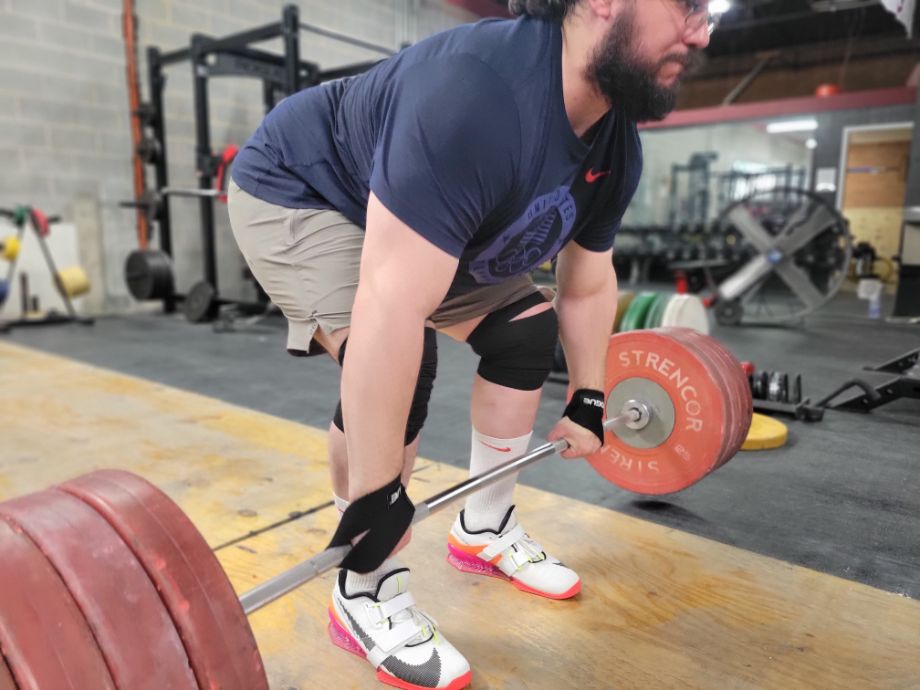
RELATED: Hip Hinge Exercises
Slowly Lower the Bar
Time and time again, I’ve seen lifters lower the bar too quickly during the Romanian deadlift. There are two downsides to this:
- It can increase the risk of injury because you’re less likely to engage your core and keep the bar close to your body.
- It doesn’t help with muscular hypertrophy (to build muscle) because you’re rushing the eccentric phase.
Keep the Bar Close
If the barbell moves away from your body during this exercise, you’ll likely create unnecessary pressure on your lower back, which may cause injuries. You’re especially at risk if your training program involves lifting heavy weights. Keeping the bar close also ensures it goes down and comes back up in a straight line, the correct Romanian deadlift technique.
Romanian Deadlift Variations
Similar to regular deadlifts, Romanian deadlifts are traditionally done with an Olympic bar. However, if you don’t have access to a bar and weight plates, don’t fret. The Romanian deadlift movement can be replicated with the best dumbbells, kettlebells, a landmine attachment, or resistance bands. I’ve also included single-leg and split-stance variations for those who prefer unilateral exercises.
See below for seven of my favorite Romanian deadlift variations:
Dumbbell Romanian Deadlift
Why do it: With barbell Romanian deadlifts, the bar starts on the floor, and you need to deadlift it up to get into the starting position. Dumbbell Romanian deadlifts begin with the dumbbells in your hands, making them much more beginner-friendly. You still work the same muscle groups and address bilateral deficits6 by holding a dumbbell in each hand.
How to do it:
- Stand with your feet shoulder-width apart, holding a dumbbell in each hand. You’ll want your arms extended, your hands by your pelvic region, and your palms facing your legs.
- Retract your shoulder blades and brace your core.
- With a slight bend in your knees, hinge at your hips so the dumbbells slowly move toward the ground. When you can’t lower any further, hold for a moment.
- Then, in a controlled manner, reverse the motion to return to the starting position.
- Repeat for the desired number of repetitions.
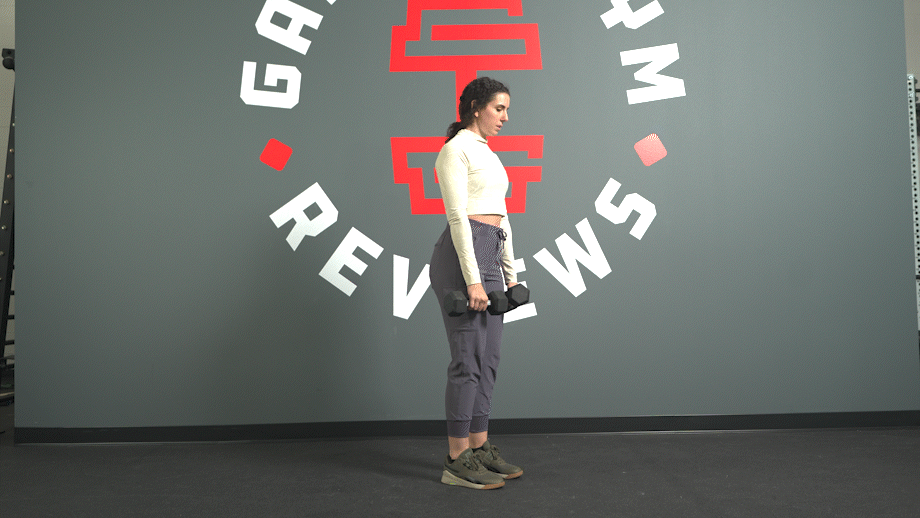
Split-Stance Romanian Deadlift
Why do it: Those looking to progress to single-leg Romanian deadlifts (you’ll see those next) can try split-stance Romanian deadlifts first. Going from regular Romanian deadlifts to the single-leg version may have a steeper learning curve if you struggle with balance. With split-stance Romanian deadlifts, your feet are on the ground, and you still get the benefits of training each side separately until your balance improves.
How to do it:
- Bring a loaded bar to the standing position, similar to how you would with regular Romanian deadlifts.
- Keeping your left foot fixed, lift your right foot off the floor and position your right toes on the ground behind you. This is the split-stance position.
- Hinge your hips so the bar moves toward the ground. You’ll want to keep your core engaged and the bar close to your body.
- Pause when the bar reaches your shins before pushing your hips forward to stand back up.
- Repeat for reps, then switch sides.
Expert tip: Although I’ve described how to do split-stance Romanian deadlifts using a barbell, you can also do this weightlifting exercise using a pair of dumbbells or kettlebells.
RELATED: Balance Exercises
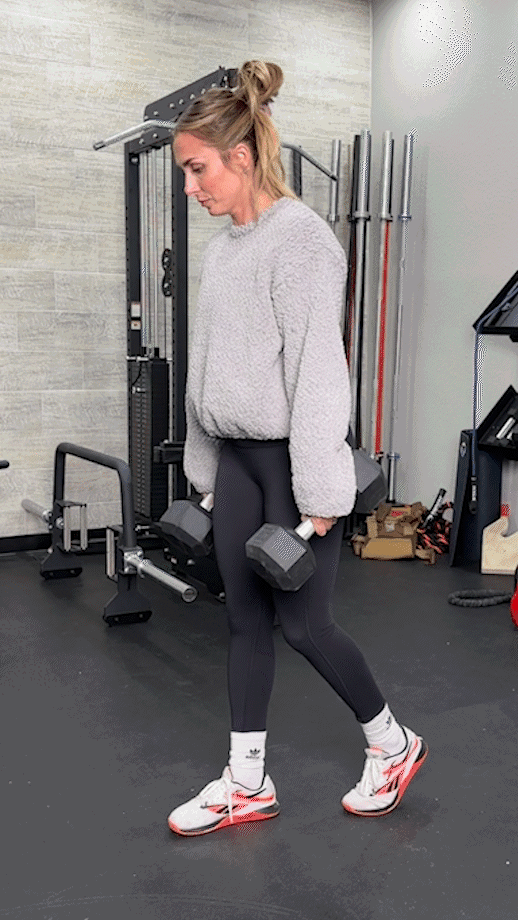
Single-Leg Romanian Deadlift
Why do it: A 2023 study by Medicine and Science in Sports and Exercise7 found that single-leg RDLs effectively target your gluteal muscles and should be included in hip-focused injury prevention or rehabilitation programs. Although you’ll need to decrease the load to perform this exercise with good form, you’ll improve your balance and stability.
How to do it:
- Stand tall with a dumbbell or kettlebell in your left hand. You’ll want your left arm extended and your left hand near your left thigh.
- Bend the right knee and shift some of your body weight onto the right-hand side.
- Lift your left foot off the ground.
- Push your right hip back and move your left leg toward the ceiling behind you. The dumbbell or kettlebell will move toward the ground here.
- Stop and pause when you feel activation in the hamstrings and lower back. Reverse the motion.
- Repeat for repetitions before replicating on the opposite side.
RELATED: Hamstring Exercises At Home
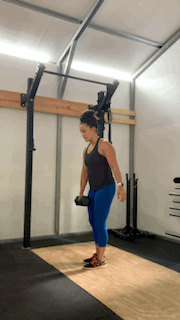
Kettlebell Romanian Deadlift
Why do it: Because the kettlebell starts in your hands, beginners may find it an ideal option to learn the hip hinge movement before moving on to the barbell version. Kettlebells are also well-known for helping improve grip strength.
How to do it:
- Take hold of a single kettlebell handle in both hands and position it in front of your body while standing up.
- Brace your core and squeeze your glutes. Move the kettlebell toward the ground by performing a hinge movement.
- When the kettlebell reaches your shins, pause before driving through the heels to return to standing.
- Keep going for reps.
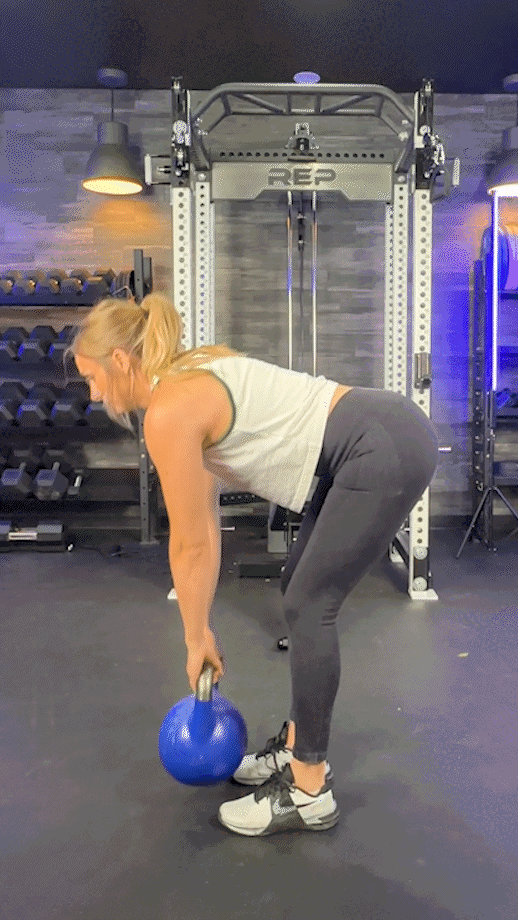
Landmine Romanian Deadlift
Why do it: Lifters finding it challenging to keep a neutral spine position during the Romanian deadlift might want to try the landmine variation. Your body stays upright during the exercise because you’re cupping your hands below the bar attachment. You may also improve your grip strength because of your hold on the sleeve of the bar.
How to do it:
- Place a barbell in the landmine base, then add the required weight plates. Stand at the end of the bar, facing the base.
- Squat down to take hold of the bar. With this strength training exercise, lifters should cup their hands below the bar.
- Stand up so the bar is at the pelvic region. If necessary, adjust your feet so they’re hip-width apart.
- Engage your core, then slowly push your hips back so the bar moves toward the ground. You’ll want a slight bend in the knees here.
- Once you’ve hit your desired range of motion, hold. To finish this hamstring exercise, stand up, squeezing your glutes as you do so.
- Continue for the desired number of repetitions.
RELATED: 11 Best Landmine Exercises
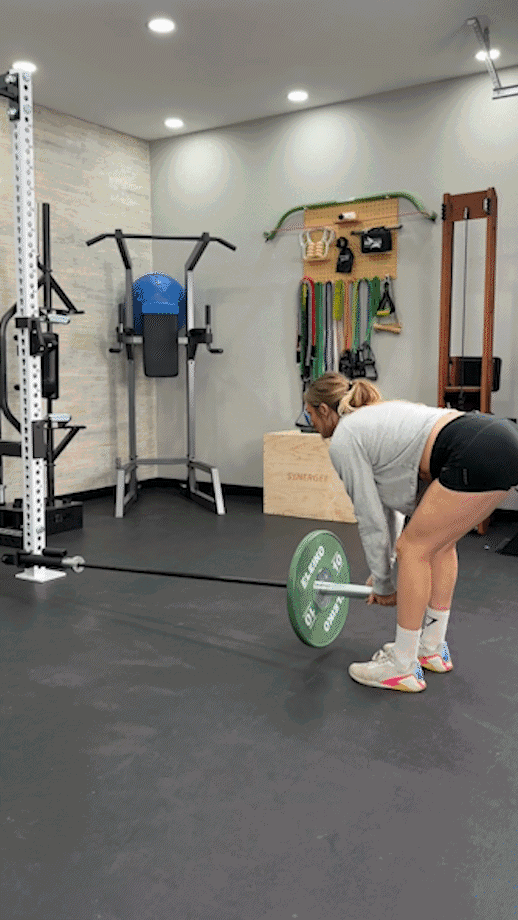
Banded Romanian Deadlift
Why do it: Resistance bands are portable, affordable, and a safer alternative to free weights. For those who travel often or don’t want to spend a lot of money on equipment for home, they’re a fantastic option. If you have a set—even better—you can increase the resistance level as you get more familiar with the Romanian deadlift exercise.
How to do it:
- Step both feet onto one of the best resistance bands. You’ll also want both hands holding the resistance band, with your hands positioned at thigh level.
- Hinge forward so your head and chest move toward the floor, ensuring your spine stays neutral throughout.
- Hold briefly, then return to the original position by pushing your hips forward.
- Repeat for reps.
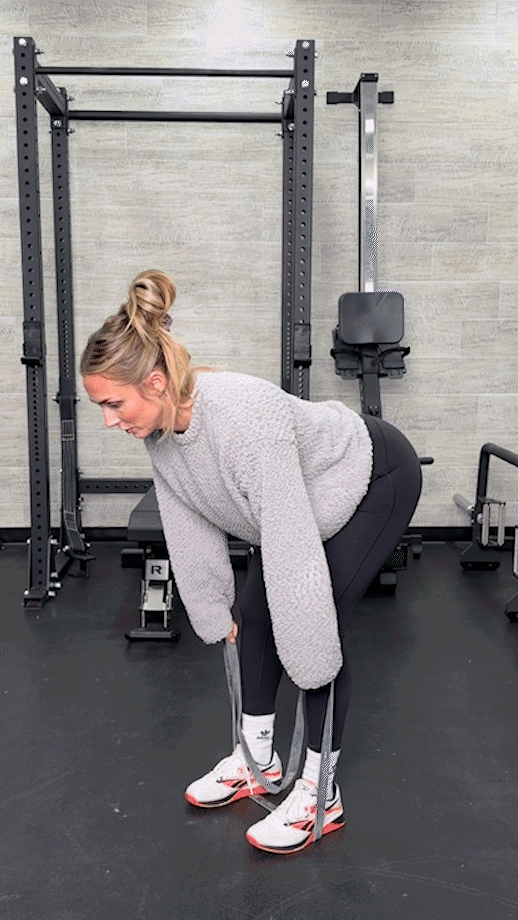
Deficit Romanian Deadlift
Why do it: Starting from a deficit increases the range of motion, getting you closer to your ankles than the middle of your shins. This can help to build more muscle in your posterior chain. If the load you can lift with Romanian deadlifts is limited (perhaps you only have one kettlebell or one set of dumbbells), adding a deficit creates an extra challenge.
How to do it:
- Stand on a low, elevated surface. You can stack two or three weight plates together and stand on them, or use a box.
- Bring the barbell to your pelvic region.
- Brace your core, then push your hips back so the bar moves towards the floor. Pause when the bar reaches the desired position before reversing the motion.
- Keep going for repetitions.
Expert tip: You can perform deficit Romanian deadlifts with dumbbells or kettlebells if you don’t have a bar and weight plates. Or, you can do split-stance and single-leg Romanian deadlifts from a deficit. However, it’s important to note that rounding your back is more common when performing deficit Romanian deadlifts, so be cautious of this if you decide to do them.
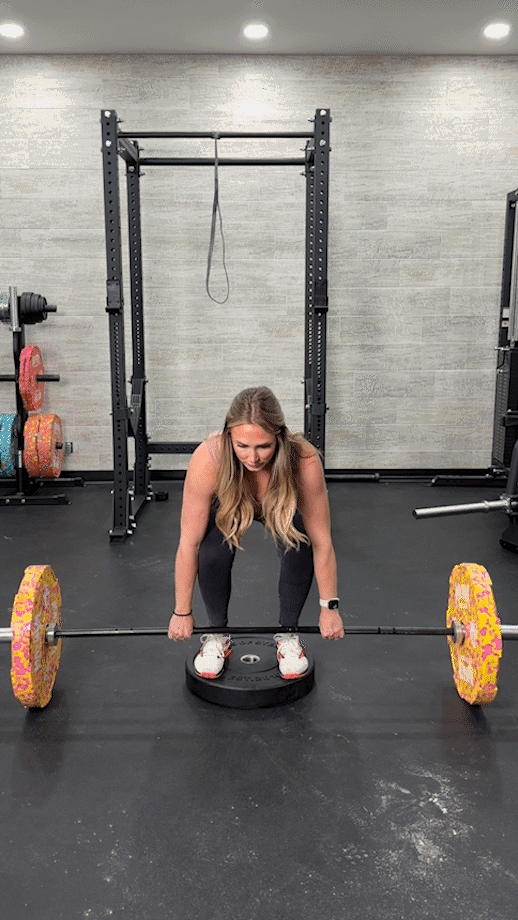
Other Types of Deadlifts
Deadlifts come in various forms, each targeting different muscle groups and offering unique benefits. Incorporating different deadlift variations into your workout routine can help you achieve a well-rounded strength program.
Standard Deadlift
Why do it: The standard or traditional deadlift is a fundamental exercise for building overall strength and muscle mass, particularly in the posterior chain, including the hamstrings, glutes, and lower back.
How to do it:
- Stand with your feet hip-width apart, with the barbell over your mid-foot.
- Bend at your hips and knees to grip the barbell with your hands slightly wider than shoulder-width apart.
- Keep your back straight and your chest up, engaging your core.
- Drive through your heels to lift the barbell, extending your hips and knees simultaneously.
- Stand up fully, keeping the bar close to your body, then lower it back to the ground in a controlled manner.
- Repeat for the desired number of reps.
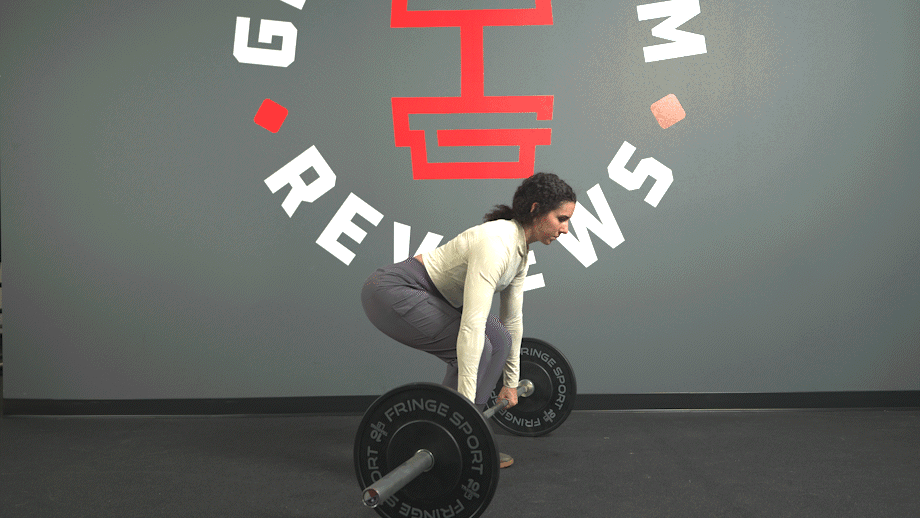
Sumo Deadlift
Why do it: The sumo deadlift emphasizes the quadriceps, inner thighs, and glutes while reducing strain on the lower back, making it a great variation for those with mobility or lower back issues.
How to do it:
- Stand with your feet wider than shoulder-width apart, with your toes pointed slightly outward.
- Grip the barbell with your hands inside your knees, using a shoulder-width grip.
- Lower your hips and keep your chest up and back straight.
- Drive through your heels and push your knees out to lift the barbell, extending your hips and knees simultaneously.
- Stand up fully, keeping the bar close to your body, then lower it back to the ground in a controlled manner.
- Repeat for the desired number of reps.
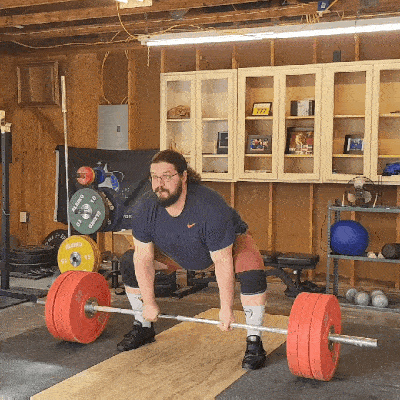
Trap-Bar Deadlift
Why do it: The trap-bar deadlift is a beginner-friendly variation that reduces stress on your lower back. This exercise helps develop lower-body strength, particularly in the quads and glutes.
How to do it:
- Stand in the center of a trap bar with your feet hip-width apart.
- Bend at your hips and knees to grip the handles of the trap bar.
- Keep your back straight, chest up, and core engaged.
- Drive through your heels to lift the bar, extending your hips and knees simultaneously.
- Stand up fully, keeping the bar close to your body, then lower it back to the ground in a controlled manner.
- Repeat for the desired number of reps.
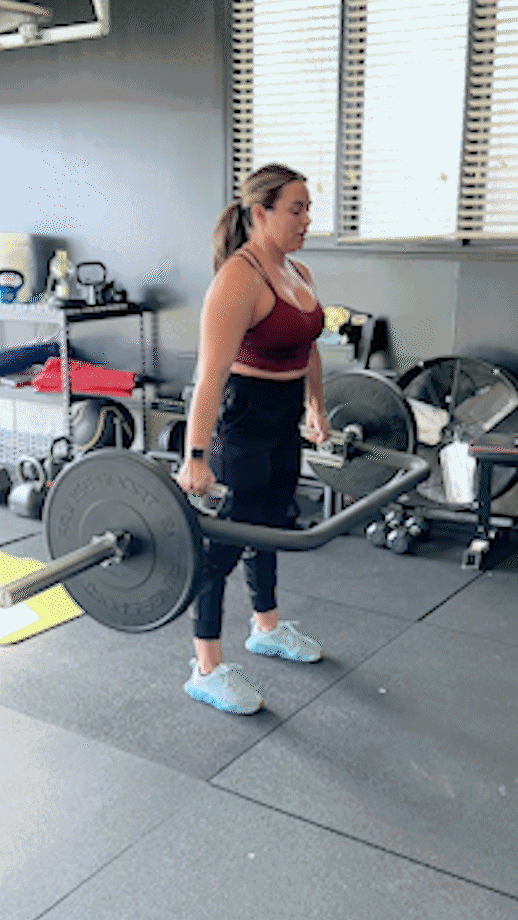
Single-Leg Deadlift
Why do it: The single-leg deadlift targets the hamstrings, glutes, and core while improving balance and stability, making it a great unilateral exercise for correcting muscle imbalances.
How to do it:
- Stand on one leg with a slight bend in your knee, holding a barbell in both hands or a dumbbell or kettlebell in hand opposite your working leg.
- Hinge at your hips to lower the weight toward the ground, extending your non-working leg behind you for balance.
- Keep your back straight and core engaged throughout the movement.
- Return to the starting position by driving through the heel of the standing leg and extending your hips.
- Repeat on your other leg.
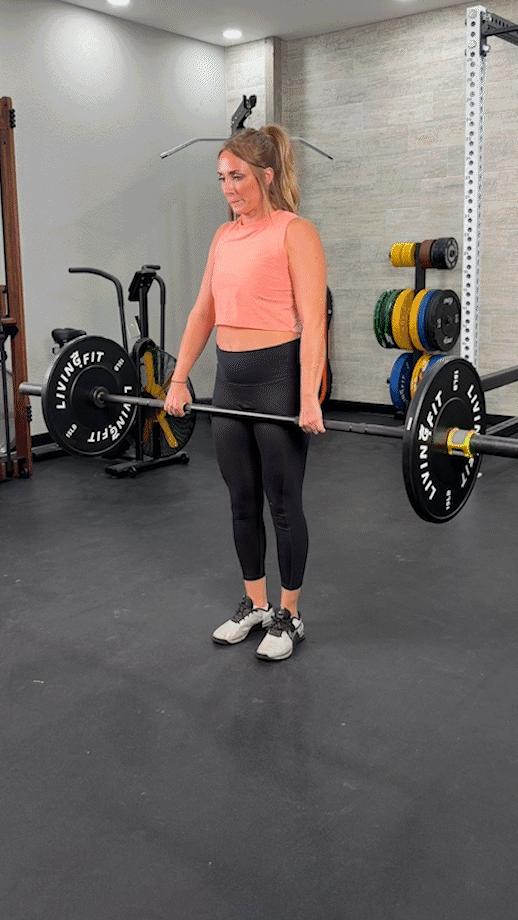
Romanian Deadlift Alternatives
If you’re looking to target the same muscle groups as the Romanian deadlift, there are several effective alternatives. These exercises focus on your hamstrings, glutes, core, and overall posterior chain.
Glute Bridge
Why do it: Glute bridges are excellent for isolating and strengthening your glutes, hamstrings, and core muscles. They are particularly beneficial for improving hip extension and addressing lower-back issues.
How to do it:
- Lie on your back with your knees bent and feet flat on the floor at hip-width apart.
- Place your arms at your sides with your palms facing down.
- Engage your core and squeeze your glutes to lift your hips off the ground until your body forms a straight line from your shoulders to your knees.
- Hold the position for a few seconds, then slowly lower your hips back to the starting position.
- Repeat for the desired number of reps.
RELATED: The Best Glute Workouts
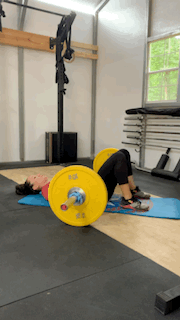
Stability Ball Hamstring Curl
Why do it: Hamstring curls with a stability ball isolate your hamstrings while engaging your glutes and core, promoting a strong, stable posterior chain.
How to do it:
- Lie on your back with your heels on top of a stability ball and your arms at your sides for support.
- Lift your hips off the ground, forming a straight line from your shoulders to your heels.
- Bend your knees to roll the ball towards your glutes, keeping your hips elevated.
- Extend your legs to roll the ball back to the starting position, maintaining control throughout the movement.
- Repeat for the desired number of repetitions.
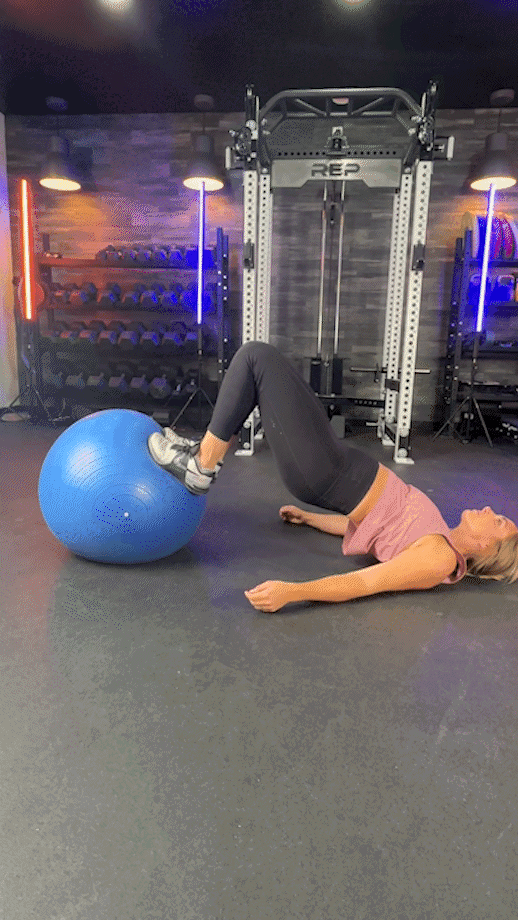
Good Morning
Why do it: Good mornings strengthen the hamstrings, glutes, and lower back, improving hip hinge mechanics and overall posterior chain strength. They are particularly effective for enhancing lower back endurance and stability.
How to do it:
- Stand with your feet hip-width apart, holding a barbell across your upper back.
- Keep a slight bend in your knees and hinge at the hips to lower your torso forward while maintaining a straight back.
- Lower until your torso is nearly parallel to the ground or you feel a stretch in your hamstrings.
- Return to the starting position by extending your hips and keeping your core engaged.
- Repeat for the desired number of repetitions.
RELATED: 16 Hip Hinge Exercises
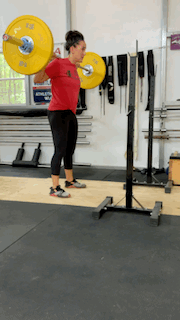
Kettlebell Swing
Why do it: Kettlebell swings are a dynamic exercise that targets the hamstrings, glutes, and core while also providing cardiovascular benefits. They improve lower-body power, hip hinge mechanics, and overall athleticism.
How to do it:
- Stand with your feet slightly wider than shoulder-width apart, holding a kettlebell with both hands.
- Hinge at the hips to swing the kettlebell back between your legs, keeping your back straight and core engaged.
- Drive your hips forward to swing the kettlebell up to shoulder height (Russian version), using the momentum generated by your hip extension.
- Allow the kettlebell to swing back down between your legs and repeat the movement in a fluid motion for the desired number of reps.
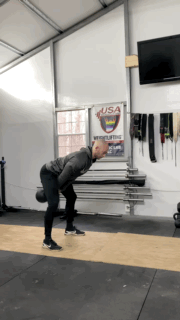
Romanian Deadlift Benefits
With deadlift variations for different fitness levels, targeted muscles, and goals, you may have wondered what sets this one apart from the rest of the pack. Here are my top three benefits of the Romanian deadlift.
Activates The Posterior Chain
Standard and Romanian deadlifts may look similar, but there are subtle differences. With Romanian deadlifts, your hips are higher, you only have a slight knee bend, and the hinge movement originates at your hips, which means that the majority of the emphasis is on the posterior chain (glutes, hamstrings, and lower back), as opposed to a combination of the quads and hamstrings that you get with traditional deadlifts.
RELATED: Best Hamstring Exercises
A 2020 systematic review published in PLoS One2 concurs—when comparing Romanian deadlifts to conventional deadlifts, there is greater activation of the biceps femoris and semitendinosus during RDLs. Both muscles—along with the semimembranosus—form the hamstring muscle group3.
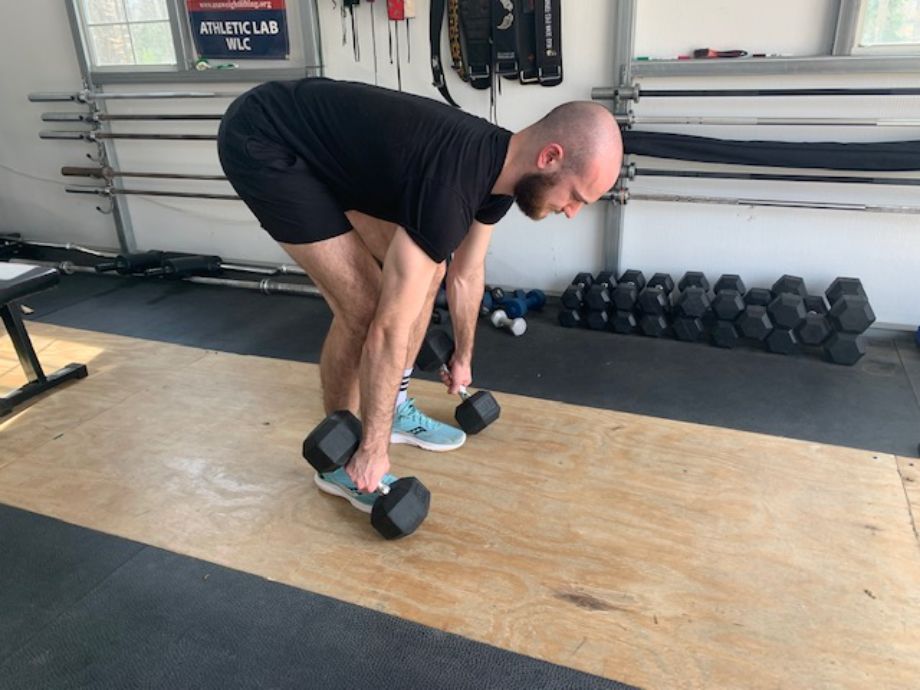
Why is this advantageous? Training your (posterior) chain elevates your athletic performance and helps strengthen and protect your lower back. A 2021 Sports Medicine-Open4 study also found that posterior chain resistance training helps alleviate low back pain for chronic sufferers compared to general exercise and walking.
Less Strain on Your Lower Back and Knees
Similarly—compared to traditional deadlifts—many gym-goers find that Romanian deadlifts are gentler on their lower back and knees. This is because your knees are locked with a slight bend, and your lower back is activated to a lesser extent. Those with previous injuries or who feel pain during standard deadlifts may find Romanian deadlifts a more comfortable alternative.
May Help Improve Other Lifts
Regularly performing Romanian deadlifts can improve your form by helping increase the flexibility of your hips and hamstrings and the amount of weight you can move during squats, conventional deadlifts, leg presses, and other lower-body exercises. These compound exercises require strong hamstrings, hip flexors and extensors, and glutes—all worked by Romanian deadlifts.
Common Romanian Deadlift Mistakes
I know you’re itching to get lifting now you understand the benefits but stick with me a little longer while I explain a few common Romanian deadlift mistakes to watch out for.
Rounding Your Back
Some pro lifters will lift with their backs rounded, and there’s high-spirited debate amongst fitness folks who say lifting with a rounded back won’t hurt your training as much as once believed. That said, I’m firmly against rounding your back when performing the Romanian deadlift, as it can be bad for your form and lumbar region.
As you lower the bar, I suggest maintaining a neutral spine position. Before you start the exercise, retract your shoulder blades and keep your chest up throughout. Lowering the bar slowly also helps lock in proper form.
Your Weight Is Too Heavy
Romanian deadlifts are an exercise where the mind-muscle connection5 is much more important than the load you lift. I’ve made the mistake of lifting too heavy on these in the past and found that my form suffered as a result—I wasn’t going all the way down to my shins. Start light, get the proper form, and the rest will follow.
Your Heels Lift Off the Floor
Your heels should be solidly on the ground throughout the movement during Romanian deadlifts. I’ve seen people shift their body weight forward and onto their toes, lifting their heels off the floor, which can cause a loss of balance and make the exercise more difficult than it needs to be.
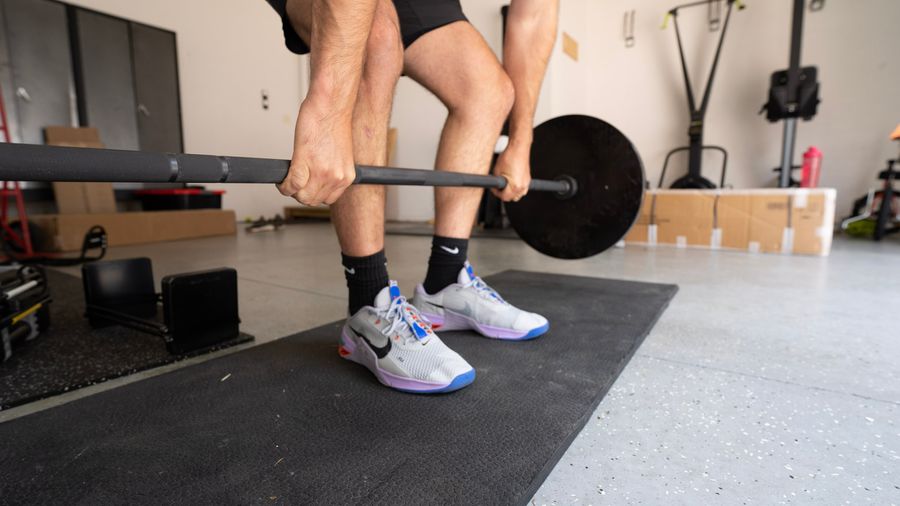
If you lower your weight and are still struggling to keep your feet planted, consider trying one of the best shoes for deadlifting to help keep your ankles stable and feet balanced.
Romanian Deadlift Safety And Precautions
When performing an RDL, it’s crucial to follow these safety tips and precautions to avoid injury and maximize the effectiveness of the exercise:
- Start with light weights: Begin with lighter weights to master the technique before gradually increasing the load.
- Focus on your hip hinge: Emphasize the hip hinge movement rather than bending at the knees to target your hamstrings and glutes.
- Keep the bar close: Keep the barbell close to your body throughout the movement to reduce strain on your lower back.
- Maintain a neutral spine: Avoid rounding your spine by engaging your core and maintaining a flat back throughout the movement.
- Avoid locking out your knees: Maintain a slight bend to protect your knee joints and ensure your hamstrings and glutes stay activated.
Romanian Deadlift: FAQs
What is the difference between a deadlift and a Romanian deadlift?
The main differences between a deadlift and a Romanian deadlift are the starting positions, the muscles activated, and where the movement originates. Regular deadlifts start with the bar on the floor, a low hip position, and bent knees, meaning the movement comes from your knees and hips, and the exercise works your quads, hamstrings, lower back, glutes, and core.
RELATED: 9 Best Quad Exercises
Romanian deadlifts are slightly different. Although you place the bar on the floor to load the weight, the starting position is when you’re standing tall with the bar at your pelvic region. Your hips are higher than a deadlift, and you only have a slight bend in your knees. Your knees are locked in place, so the movement originates from your hips only, which places more emphasis on your hamstrings and glutes when compared to a traditional deadlift.
What is a Romanian deadlift good for?
The Romanian deadlift can help strengthen your posterior chain, improve your hip hinge mechanics, and enhance your hamstring flexibility. This compound exercise also effectively engages your core muscles.
What is the difference between a squat and a Romanian deadlift?
Although a 2020 study by the Journal of Human Kinetics8 found that squats and deadlifts can result in similar improvements in lower body maximal strength and jump performance, there are key differences. Squats mainly work your quads and core (the anterior chain), whereas Romanian deadlifts hit the hamstrings, glutes, and lower back (the posterior chain). As a certified personal trainer, I would recommend including both exercises in your workout routine.
What does Romanian deadlift work?
Romanian deadlifts mainly work the muscles in your posterior chain, including your hamstrings, glutes, and lower back. You’ll also hit your core to an extent because, during the exercise, it’s important to keep your core braced to protect the lumbar spine. Another benefit of Romanian deadlifts is that they help improve your grip strength for other lifts.
RELATED: Grip Strength Exercises
References
- McAllister MJ, Hammond KG, Schilling BK, Ferreria LC, Reed JP, Weiss LW. Muscle activation during various hamstring exercises. J Strength Cond Res. 2014 Jun;28(6):1573-80. doi: 10.1519/JSC.0000000000000302. PMID: 24149748.
- Martín-Fuentes I, Oliva-Lozano JM, Muyor JM. Electromyographic activity in deadlift exercise and its variants. A systematic review. PLoS One. 2020 Feb 27;15(2):e0229507. doi: 10.1371/journal.pone.0229507. PMID: 32107499; PMCID: PMC7046193.
- Hamstrings. (2022, August 24). Physiopedia, . Retrieved 20:18, February 27, 2024 from https://www.physio-pedia.com/index.php?title=Hamstrings&oldid=315531.
- Tataryn N, Simas V, Catterall T, Furness J, Keogh JWL. Posterior-Chain Resistance Training Compared to General Exercise and Walking Programmes for the Treatment of Chronic Low Back Pain in the General Population: A Systematic Review and Meta-Analysis. Sports Med Open. 2021 Mar 8;7(1):17. doi: 10.1186/s40798-021-00306-w. PMID: 33683497; PMCID: PMC7940464.
- Calatayud J, Vinstrup J, Jakobsen MD, Sundstrup E, Brandt M, Jay K, Colado JC, Andersen LL. Importance of mind-muscle connection during progressive resistance training. Eur J Appl Physiol. 2016 Mar;116(3):527-33. doi: 10.1007/s00421-015-3305-7. Epub 2015 Dec 23. PMID: 26700744.
- Škarabot J, Cronin N, Strojnik V, Avela J. Bilateral deficit in maximal force production. Eur J Appl Physiol. 2016 Dec;116(11-12):2057-2084. doi: 10.1007/s00421-016-3458-z. Epub 2016 Aug 31. PMID: 27582260.
- Collings TJ, Bourne MN, Barrett RS, Meinders E, GONçALVES BAM, Shield AJ, Diamond LE. Gluteal Muscle Forces during Hip-Focused Injury Prevention and Rehabilitation Exercises. Med Sci Sports Exerc. 2023 Apr 1;55(4):650-660. doi: 10.1249/MSS.0000000000003091. PMID: 36918403.
- Nigro F, Bartolomei S. A Comparison Between the Squat and the Deadlift for Lower Body Strength and Power Training. J Hum Kinet. 2020 Jul 21;73:145-152. doi: 10.2478/hukin-2019-0139. PMID: 32774546; PMCID: PMC7386153.


